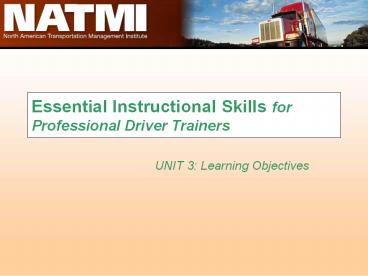Essential Instructional Skills for Professional Driver Trainers - PowerPoint PPT Presentation
1 / 26
Title: Essential Instructional Skills for Professional Driver Trainers
1
Essential Instructional Skills for Professional
Driver Trainers
- UNIT 3 Learning Objectives
2
Lesson Objectives
- Youll be able to
- Analyze a job for training needs
- Write clear instructional objectives
- Identify the three major types of objectives and
give examples of each
3
Task Analysis
- The blueprint for training
- Provides effective measurement of performance of
every aspect of a particular job - Sets expectations for the employee and shows
where performance can be improved - Areas for improvement create the goals for the
training program
4
Task Analysis Includes
- Job title
- Major tasks of the job
- Sub-tasks
- Qualitative standards
- Quantitative standards
- Skills and educational requirements
5
Task Analysis Includes (Contd)
- Materials and instruments needed
- Time-frames, deadlines
- Limitations anticipated and to be overcome
- Resources
- Preferred methods
- Other considerations
6
Task Analysis Provides
- Efficient measures of production
- Accurate indicators of training needs
- Instruments for forecasting future production and
needs - Sets expectations for each employee
- Opportunities for employees to think about their
job
7
Task Analysis Provides (Contd)
- Fair methods of evaluating performance
- Simple ways of documenting reports
- Handy devices for filling vacancies
- Elimination of buck-passing
- Writing of instructional objectives
8
Job Safety Analysis (JSA)
- A written procedure designed to review job
methods, uncover hazards, and recommend safe job
procedures
9
4 Steps in Developing the JSA
- 1. Selecting the job
- 2. Breaking down the job into a sequence of steps
- 3. Identifying potential hazards of each step
- 4. Recommending safe job procedures
10
The JSA Process Includes
- A listing of how the person performs the job one
step at a time - A listing of potential hazards for each job step
- What the person must do to avoid the hazard or
accident
11
The JSA Process Includes (Contd)
- A series of reviews by the operator, supervisor,
and other operators plus supervisors with similar
jobs - Specific recommendations for performing the job
safely
12
Training and the JSA
- The list of recommendations for performing the
job safely form a set of goals for training
sessions to be held - Problems to be resolved through training may be
ranked in sequence based on - potential hazard
- liability
- productivity or
- greatest cost
13
Performance Objective
- An objective is the desired outcome of a learning
situation, stated in terms of observable behavior
of the learner - The observable behavior is the exact performance
that the learner is able to display as a result
of a particular training process
14
Preparing Performance Objectives
- Decide upon the goals to reach at the end of the
program - Select procedures, content and methods that are
relevant to the objective - Measure or evaluate the trainees performance
according to the objectives or goals originally
selected
15
4 Parts of an Objective
- 1. Learning
- 2. Behavior
- 3. Conditions
- 4. Performance level
16
Examples of Objectives
- GOOD The trainee will be able to correctly
convert ten decimal numbers into the binary
system in one minute. - BAD The trainer will lecture on the number
system. - GOOD The trainee will be able to compose one
business letter every 15 minutes, with no
grammatical errors. - BAD The 20 minute video will teach How to
Compose Better Letters.
17
Instructional Objectives
- Tell both teacher and examiners what is to be
learned - Give directions to both teacher and students
- Give the teacher a specific target
18
Statements of Objectives
- Prepared statements of objectives are crucial to
the success of training programs - When objectives are clear, the chances of
misunderstanding are greatly reduced
19
3 Types of Objectives
- Knowledge
- Attitudes
- Skills
20
Knowledge Objectives
- Acquire knowledge
- Comprehend
- Apply
- Analyze or
- Evaluate
21
Attitude Objectives
- Values
- Beliefs
- Appreciations
- Interests
22
Skills Objectives
- Application of knowledge and attitudes through
behavior
23
Measure of a Good Objective
- If you provide another teacher with an objective,
and he or she then teaches students to perform in
a manner that you agree is consistent with what
you had in mind, then you have effectively
communicated your objective.
24
Wording of Objectives
- The best statement of objective is one that
excludes the greatest number of alternatives to
your goal.
25
Words Open to Many Interpretations
- to know
- to appreciate
- to grasp the significance of
- to enjoy
- to believe
- to have faith in
- to understand
26
Words Open to Fewer Interpretations
- to write
- to recite
- to identify
- to differentiate
- to solve
- to construct
- to list
- to compare
- to contrast































